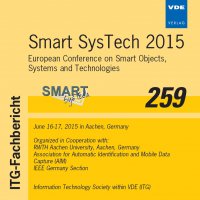Indoor-to-Outdoor Radio Channel Measurements in sub-GHz Unlicensed Frequency Bands
Konferenz: Smart SysTech 2015 - European Conference on Smart Objects, Systems and Technologies
16.07.2015 - 17.07.2015 in Aachen, Germany
Tagungsband: Smart SysTech 2015
Seiten: 9Sprache: EnglischTyp: PDF
Persönliche VDE-Mitglieder erhalten auf diesen Artikel 10% Rabatt
Autoren:
Lieske, Hendrik; Robert, Joerg; Heuberger, Albert (Friedrich-Alexander-Universität Erlangen-Nürnberg (FAU), Information Technology (Communication Electronics), 91058 Erlangen, Germany)
Lauterbach, Thomas (Technische Hochschule Nürnberg Georg Simon Ohm, 90489 Nürnberg, Germany)
Kilian, Gerd (Fraunhofer Institute for Integrated Circuits IIS, 91058 Erlangen, Germany)
Inhalt:
In this paper we present a newly developed measurement system for studying the long-term properties of indoor-tooutdoor radio channels at 169.4 - 169.475, 433 - 434.8 and 863 - 870 MHz. It is based on a large number (up to 50) of batteryoperated low cost transmitters that are spread in the area of interest, e.g. in different rooms of a building or in different houses. They are able to send narrow-band MSK modulated data packets in 3, 7 and 27 channels in the three frequency bands every few minutes for several weeks without maintenance. The receiving station uses a software defined radio front end (Ettus USRP B210) and two antennas for each band, e.g. a vertically and a horizontally polarized omni-directional antenna. The large bandwidth of the USRP and the high signal processing power of a PC allows to receive all channels simultaneously and to decode packets received from the different transmitters. Signal level, SNR and BER are estimated for each packet and written to an XML data file for further processing. The paper describes the signal design and the packet structure, the algorithms used for decoding and the performance of the receiver with respect to synchronization capability and sensitivity. For signal level estimation, the whole system was calibrated in a wide range (??120dBm to ??40 dBm) and the performance of the rubber antennas used on the transmitters was measured. A first field trial making use of the system was carried out at the Fraunhofer Institute for Integrated Circuits IIS building at Erlangen from August to October, 2014. It showed the feasibility of the system design and the long-term reliability of transmitter and receiver hard- and software. Initial results on the variability of signal levels over several days, on frequency selectivity and path loss of indoor-to-outdoor channels in the range 10m to 100m are presented.


